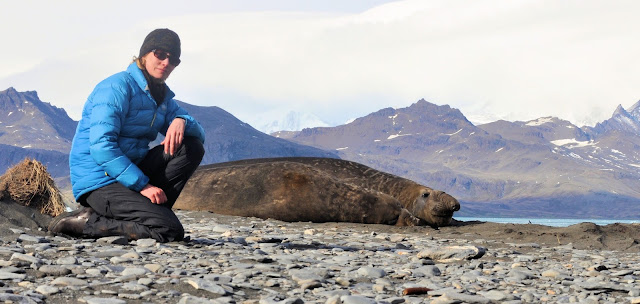 |
Elephant seal pups like their parents like to doze away
their days in wallows of rotting sea weed. |
We are almost at the end of our expedition to South Georgia. Worsening weather around the South Sandwich Islands has meant that the Polarstern has had to abandon some of it’s seabed surveying and has spent some days in the leeward side of one of the islands. More prospects of worsening weather means that the ship is making its way back to the relative shelter of the South Georgia fjords and wants to collect us a few days earlier than expected to make our final destination of the Falkland Islands on time.
While the weather has been rough at sea we have had relatively good conditions on land, and certainly it has been good enough for us to work every day of our visit so far. We have completed taking the lagoon cores for reconstructing the past environment through time and have also finished collecting rock samples for cosmogenic dating the glacier activity. The final lagoon sediment core is 13m in length and now safely contained within tubes. I have also completed a vegetation survey to look at the current types of land plants around the lagoon and aquatic plants along the shore line. There are broad plant zones with increasing altitude away from the lagoon from large tussock grass around the lagoon margins because this large leaved grass prefers sheltered damp conditions, to tiny mosses and bryophytes on the high slopes. The mosses and bryophytes are so called pioneer plant types as they prefer thin soils and rocky landscapes, and can endure harsh, high altitude weather conditions.
 |
| Me at a safe distance from a group of male elephant seals which were between 4-5 m in length |
Looking for signals about how the proportions of the various plant communities have changed through time will tell us about how the landscape has changed under changing climates. We assume that immediately after the glaciers retreated the pioneer plant communities would soon have develop, but with warmer and wetter conditions other species would have arrived, and the pioneers would migrate to the steeper slopes. Since evidence for actual plants in the sediments maybe restricted to a few seeds, pollen grains and plant fragments I will also be looking for climate signals in the modern plants mainly in the form of their carbon isotope and compound specific signatures. If these compounds are preserved in the tiny fragments of plant material we can extract from the core sediments then we may be able to identify the dominant sources of organic material into the lake and hence environmental change.
 |
| The distinctive feature of the male elephant seal is their trunk like nose |
The wild life is still omnipresent. Yesterday I came across a group of male elephant seals, which were all between 4-5 m in length, and so called because of their inflatable trunk-like nose. While these animals are quite passive on land (having no predators) they will treat you to a roaring bellow and a comical wriggle of their massive bodies if approached. At sea they are ferocious predators; they dive to depths in excess of 1000 m in the hunt for squid, their main food source. We tend to avoid the elephant seals because they are one of the most pungent creatures I have ever come across due to their liking for wallowing in rotting sea weed.
South Georgia is an amazing island, visited by few, which is probably why it remains such a special place. In a few days I will be back on board the Polarstern, and I am sure I will be glad of hot water, dry clothes and proper food. I’m hoping that before we head to the Falkland Islands we will be able to visit the British Antarctic Survey’s research base at King Edward Point next to the old whaling station of Grytviken if the weather permits. The staff at the King Edward Point research base have been a great support to us, advising us before we arrived here and being in regular contact during our stay. Their weather reports have been gratefully received. Many thanks to Jo, Rod and Keiron at King Edward Point and Les at the British Antarctic Survey in Cambridge.
More information on the wildlife of South Georgia can be got from Robert Burton and John Croxall’s book entitled A Field Guide to the Wildlife of South Georgia.
Mel Leng
Melanie Leng is on an expedition to South Georgia, see her previous blogs, and follow her on twitter @MelJLeng

Comments